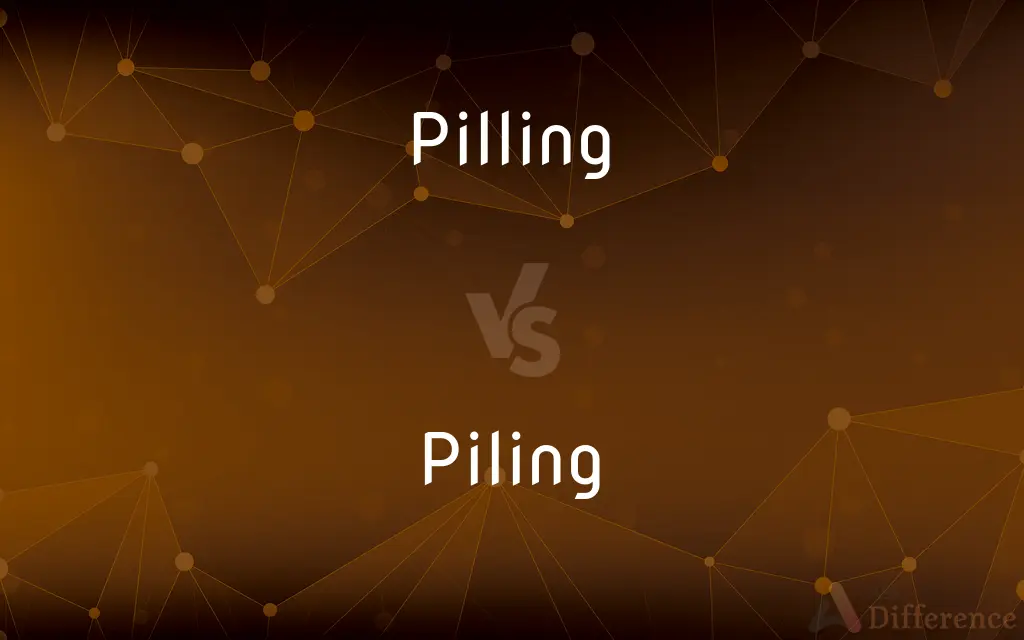Pilling vs. Piling — What's the Difference?
Edited by Tayyaba Rehman — By Fiza Rafique — Updated on April 26, 2024
Pilling refers to the formation of small, fibrous balls on fabric surfaces due to wear, whereas piling involves stacking objects or materials on top of each other.

Difference Between Pilling and Piling
Table of Contents
ADVERTISEMENT
Key Differences
Pilling occurs when fibers in textiles break and roll up into tiny balls on the surface, commonly due to friction or wear. On the other hand, piling refers to the act of layering items vertically, often to create a stack or heap.
Fabric pilling is often seen as undesirable and can affect the aesthetic and texture of clothing or upholstery. Conversely, piling is a practical activity used in construction, storage, or simply organizing space efficiently.
The causes of pilling include rubbing and repeated use, which loosen fibers from the fabric. Whereas piling can be intentional, such as when constructing a foundation with piles in the ground, or incidental, like when stacking books or dishes.
Preventative measures for pilling might involve choosing higher quality fabrics or using specific washing techniques. In contrast, effective piling may require planning and consideration of structural stability, especially in engineering and construction contexts.
While pilling primarily affects textiles, impacting garments, furniture, and other fabric-covered items, piling has broader applications, including architecture, logistics, and everyday organization.
ADVERTISEMENT
Comparison Chart
Definition
Formation of small balls of fiber on fabric.
Stacking objects or materials on top of each other.
Context
Textiles, clothing, upholstery.
Construction, storage, organization.
Cause
Friction, wear, material quality.
Intentional stacking, need for organization.
Impact
Affects appearance and texture of fabrics.
Affects structure, space usage.
Prevention/Solution
Use of anti-pilling fabrics, proper washing.
Strategic planning, structural support.
Compare with Definitions
Pilling
Affects the texture and aesthetic of textiles.
She used a fabric shaver to remove the pilling on her coat.
Piling
Essential in construction for creating strong foundations.
Steel pilings were used to support the new bridge.
Pilling
A common issue in synthetic and natural fibers alike.
To prevent pilling, avoid rough washing cycles.
Piling
Can refer to accumulation or gathering in large quantities.
Leaves were piling up in the backyard during fall.
Pilling
The formation of small, fibrous balls on fabric due to friction.
The sweater started pilling after several washes.
Piling
Utilized for both practical and organizational purposes.
Piling the sandbags prevented floodwaters from spreading.
Pilling
Considered a wear and tear phenomenon in clothing.
Frequent use led to noticeable pilling on his favorite hoodie.
Piling
The act of stacking objects or materials vertically.
He spent the afternoon piling books back on the shelf.
Pilling
Pilling is a village and civil parish within the Wyre borough of Lancashire, England. It is 6.5 miles (10.5 km) north-northeast of Poulton-le-Fylde, 9.4 miles (15.1 km) south-southwest of Lancaster and 14.5 miles (23.3 km) northwest of Preston, in a part of the Fylde known as Over Wyre.
Piling
Often involves strategic placement for stability.
Careful piling of boxes ensured they wouldn’t topple over.
Pilling
A small pellet or tablet of medicine, often coated, taken by swallowing whole or by chewing.
Piling
See pile2.
Pilling
(Informal) An oral contraceptive. Used with the.
Piling
The act of driving piles.
Pilling
(Slang) Something, such as a baseball, that resembles a pellet of medicine.
Piling
Piles considered as a group.
Pilling
Something both distasteful and necessary.
Piling
A structure composed of piles.
Pilling
(Slang) An insipid or ill-natured person.
Piling
A structural support comprising a length of wood, steel, or other construction material.
Pilling
To dose with pills.
Piling
The act of heaping up.
Pilling
To make into pills.
Piling
(ironworking) The process of building up, heating, and working fagots or piles to form bars, etc.
Pilling
(Slang) To blackball.
Piling
Present participle of pile
Pilling
To form small balls resembling pills
A sweater that pills.
Piling
The act of heaping up.
Pilling
To come off, as in flakes or scales.
Piling
The process of building up, heating, and working, fagots, or piles, to form bars, etc.
Pilling
To subject to extortion.
Piling
A series of piles; piles considered collectively; as, the piling of a bridge.
Pilling
Present participle of pill
Piling
A column of wood or steel or concrete that is driven into the ground to provide support for a structure
Pilling
Balls of fibre formed on clothing through usage, often called pill or pills.
Pilling
Can be minimized with careful maintenance.
Choosing high-quality fabrics can reduce the chances of pilling.
Common Curiosities
What is the main difference between pilling and piling?
Pilling refers to the formation of small fabric balls, whereas piling involves stacking objects.
What are common uses of piling in construction?
Piling is used to provide foundation support in buildings and bridges.
What materials are more prone to pilling?
Fabrics like polyester, nylon, and sometimes wool are prone to pilling.
Does pilling affect all types of fabric?
Most types of fabric can pill under certain conditions, though quality plays a role.
Can piling be done with any materials?
Yes, but the choice of material depends on the purpose and required stability.
What is the structural significance of piling?
It provides stability and support, especially in soft soil conditions.
Can pilling be prevented?
Yes, by using higher quality fabrics and proper washing techniques.
Is pilling reversible?
While not completely reversible, pilling can be managed by removing pills with a fabric shaver.
How does piling help in flood control?
By stacking sandbags or other barriers to prevent water from spreading.
How does one choose materials to prevent pilling?
Opting for tightly woven, high-quality fibers can reduce pilling.
Share Your Discovery

Previous Comparison
Arrogant vs. Obnoxious
Next Comparison
Chic vs. ChickAuthor Spotlight
Written by
Fiza RafiqueFiza Rafique is a skilled content writer at AskDifference.com, where she meticulously refines and enhances written pieces. Drawing from her vast editorial expertise, Fiza ensures clarity, accuracy, and precision in every article. Passionate about language, she continually seeks to elevate the quality of content for readers worldwide.
Edited by
Tayyaba RehmanTayyaba Rehman is a distinguished writer, currently serving as a primary contributor to askdifference.com. As a researcher in semantics and etymology, Tayyaba's passion for the complexity of languages and their distinctions has found a perfect home on the platform. Tayyaba delves into the intricacies of language, distinguishing between commonly confused words and phrases, thereby providing clarity for readers worldwide.














































